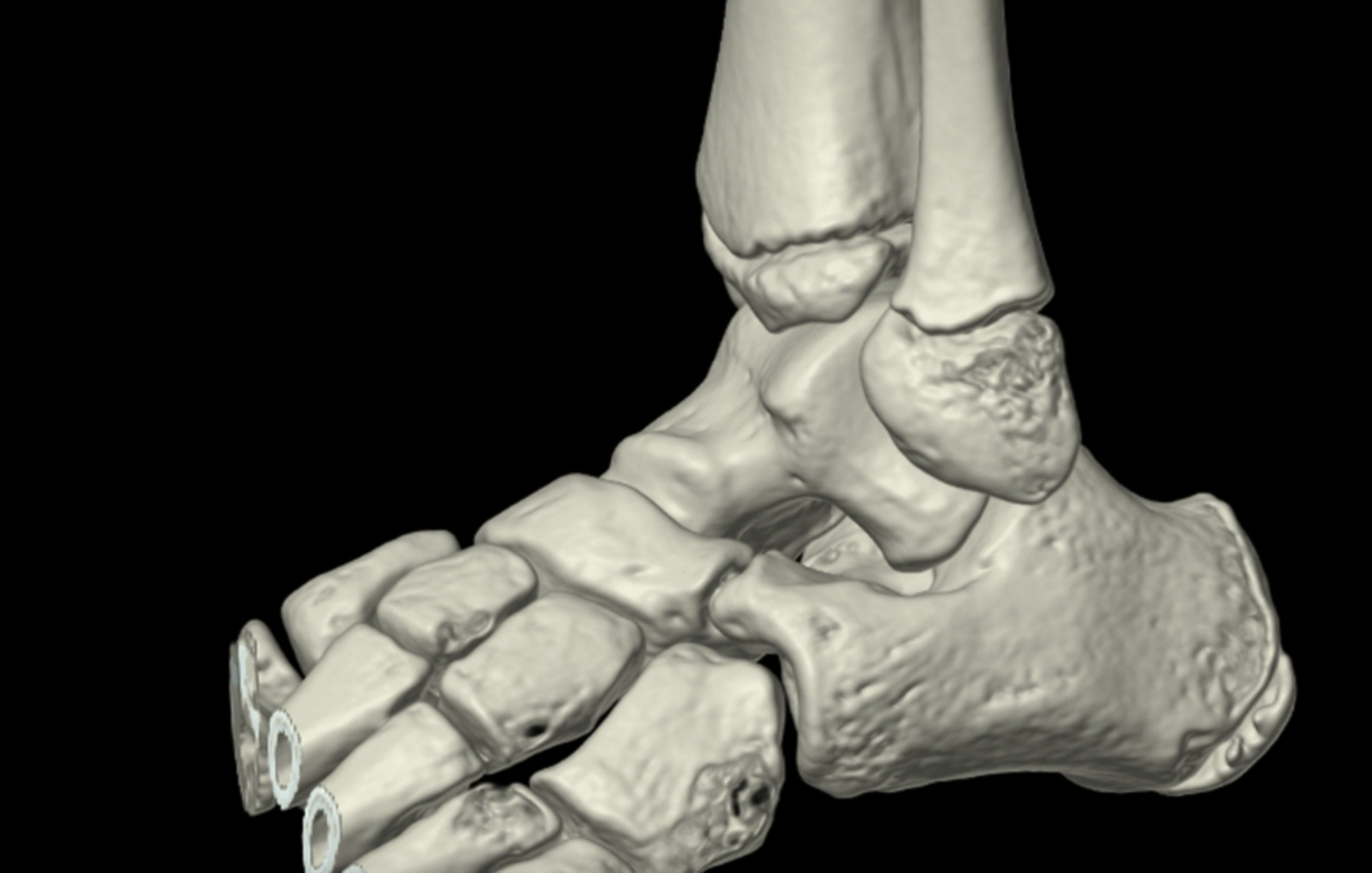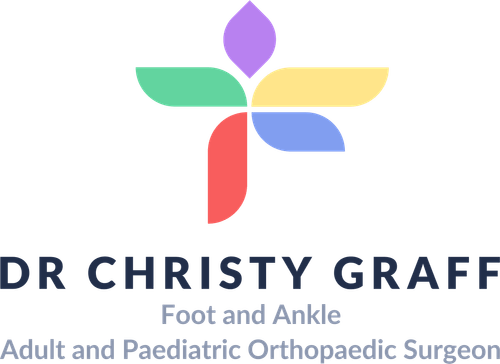Tarsal Coalition Excision
What is Tarsal Coalition Excision?
Tarsal Coalition Excision is a surgical procedure that addresses a condition called tarsal coalition. Tarsal coalition occurs when two or more bones in the foot (tarsal bones) are abnormally connected by fibrous, cartilaginous, or bony tissue. This abnormal connection can limit foot motion, cause pain, and lead to other complications, such as flatfoot.
Tarsal coalition excision removes the abnormal connection between the tarsal bones, allowing for improved foot movement, reduced pain, and restored function. This procedure can be combined with techniques to reinforce the foot’s stability, such as using bone grafts or implants.

Who is Suitable for Tarsal Coalition Excision?
Tarsal coalition excision is typically recommended for individuals who:
- Have Significant Symptoms: Patients with persistent pain, stiffness, or limited mobility in the foot that does not respond to non-surgical treatments like physiotherapy, orthotics, or anti-inflammatory medications.
- Are Young or Active: Younger individuals and active patients may benefit the most, as restoring foot motion is crucial for maintaining mobility and an active lifestyle.
- Have Mild to Moderate Cases: The procedure is suitable for cases where the coalition involves a smaller, isolated area of the tarsal bones and does not severely affect the overall structure of the foot.
- No Significant Arthritis: Patients without advanced arthritis in the affected joint are better candidates for excision since arthritis may require a different approach, such as joint fusion.
Benefits of Tarsal Coalition Excision
The benefits of tarsal coalition excision include:
- Pain Relief: Removing the abnormal connection alleviates pain caused by the coalition.
- Improved Mobility: Restores range of motion and flexibility in the foot.
- Enhanced Function: Enables patients to resume physical activities and daily tasks; the foot may feel different to the side without the coalition.
- Prevention of Further Damage: Early intervention can prevent secondary problems, such as worsening flatfoot or arthritis.
- Minimal Long-Term Restrictions: Unlike joint fusion, excision preserves motion in the foot, offering better long-term outcomes for active patients.
Types of Tarsal Coalition Excision
The type of excision depends on the location and nature of the coalition. Common types include:
- Calcaneonavicular Coalition Excision: This type addresses coalitions between the calcaneus (heel bone) and the navicular bone.
- Talocalcaneal Coalition Excision: This type involves removing coalitions between the talus and calcaneus bones. It is a more complex procedure and may require additional correction techniques, such as foot reshaping.
Alternative Options to Tarsal Coalition Excision
For patients who may not be suitable candidates for tarsal coalition excision or prefer non-surgical treatments, alternative options include:
- Non-Surgical Management:
- Custom Orthotics: Special shoe inserts to support and reduce foot stress.
- Physiotherapy: Exercises to strengthen foot muscles and improve mobility.
- Medications: Anti-inflammatory drugs to manage pain and swelling.
- Activity Modification: Reducing activities that exacerbate symptoms.Steroid Injections: Temporary relief from pain and inflammation in the affected area.
- Joint Fusion (Arthrodesis): For severe cases with advanced arthritis or instability, fusion of the affected joints may be considered. This eliminates pain but sacrifices joint motion.
Preparation Before a Tarsal Coalition Excision
Before undergoing tarsal coalition excision, patients should take the following steps:
- Consultation and Diagnosis: To confirm the presence and extent of the tarsal coalition, undergo a thorough evaluation, including physical examination and imaging studies such as X-rays, CT scans and/or MRI.
- Non-Surgical Treatment Trial: Attempt conservative treatments like rest, orthotics, physiotherapy, or anti-inflammatory medications, as these are typically recommended before considering surgery.
- Prepare for Recovery: Arrange for assistance with daily activities during recovery. Prepare a comfortable home space with necessary supplies, such as crutches or a walker.
- Lifestyle Adjustments: Maintain a healthy diet and refrain from smoking to optimise healing after surgery.
Tarsal Coalition Excision Procedure
- The surgery involves an incision over the coalition area.
- The coalition is identified using x-rays in theatre and knowledge of anatomy (Nerves and tendons in the area are protected).
- The coalition is excised.
- Sometimes, further foot reconstruction is required.
The Hospital Stay
- Your child will wake up with bulky bandages and a boot.
- Your child’s foot will be elevated overnight, and antibiotics will be received through a drip.
- Your child can walk in the boot the next day, but just for necessary things like going to the toilet. Otherwise, your child’s foot will become too swollen.
At Home
- Your child will need medications for pain relief, which will be given to you from the hospital (paracetamol and ibuprofen can be bought over the counter). Stronger painkillers are often required in the first week, especially if a reconstruction is required.
- The first night after surgery is often when the worst pain is experienced, and the local anaesthetic wears off. Please give your child stronger painkillers before they go to sleep.
- Please leave all dressings and the boot intact until your appointment with Dr Graff in 2-3 weeks.
- Your child will get an appointment for your post-op appointment in 2-3 weeks, during which the wounds will be reviewed, and the suture ends trimmed (absorbable sutures are usually used).
- After this, your child can shower normally and pat the dressings dry.
Tarsal Coalition Excision Rehabilitation
All patients are different, and these timelines are only guides. Some may progress faster or slower than others.
0 - 2 Weeks
- Your child can weight bear as tolerated in a boot, but only for essential things.
- Keep elevated at other times.
- Keep the boot on at all times like a plaster.
- Pain relief: Please give your child regular Panadol with meals and before bed.
2 - 3 Weeks
- Post-op appointment with Dr Graff: dressings changed.
- Your child is allowed to weight bear as tolerated in the boot.
- Your child can remove the boot for showers, sleeping, and range of motion exercises with physio.
- Your child can start static strengthening and balance exercises with physio.
4 - 6 Weeks
- Your child can transition from the boot into normal sports shoes if the swelling allows.
- Your child can start increasing strength with physio and a wobbleboard.
10 - 12 Weeks
- Your child can ease back into sport – start with walking, running, then training.
- Once your child’s ankle feels as strong as the normal ankle, your child can return to sport (also be guided by your physio).
When can I return to work/school?
- 3-4 weeks if seated work.
- 10-12 weeks if your job/school requires prolonged standing.
- 3-6 months if your job requires heavy labour and for sports at school.
When can I drive?
- Left foot: 2-3 weeks if the surgery (if driving an automatic car).
- Right foot: -6 weeks if surgery (when the boot is no longer required).
When can I return to sport?
- It will take at least three months, but this is a transition. Start with walks and running and then training. Your physiotherapist can guide you on when your child’s strength and range of motion will return to normal so that your child can return to competitive sport.
Tarsal Coalition Excision Prognosis
The prognosis after tarsal coalition excision is generally excellent, especially for younger patients and those with limited coalition involvement. Outcomes include:
- Pain Relief: Most patients experience a significant reduction or complete resolution of pain.
- Improved Mobility: Restored foot function and range of motion.
- High Success Rate: Studies show that excision has a high success rate, with low recurrence of symptoms when proper postoperative care is followed.
- Enhanced Quality of Life: Patients can often return to daily activities and sports without limitations.
Tarsal Coalition Excision Risks
Like any surgical procedure, tarsal coalition excision carries some risks, including:
- Anaesthetic problems
- Nerve or tendon injury
- Infection
- Ongoing pain and/or stiffness requiring further surgery
- The coalition re-forms
What if Tarsal Coalition Excision is Delayed?
Delaying treatment for a symptomatic tarsal coalition can lead to several complications:
- Increased Pain
- Reduced Mobility
- Flatfoot deformity or secondary arthritis
- Reduced Treatment Options
- Lower Quality of Life
Timely diagnosis and treatment are essential to prevent these potential complications and ensure optimal outcomes.
Please see the ‘Tarsal Coalition’ Information sheet here.
Contact Us
If you want more information or have any questions or problems, please contact Dr Graff at admin@christygraff.com or call the rooms at 0493 461 133.
Tarsal Coalition Excision Information Sheet
Menu
Address
All Rights Reserved | Dr Christy Graff
